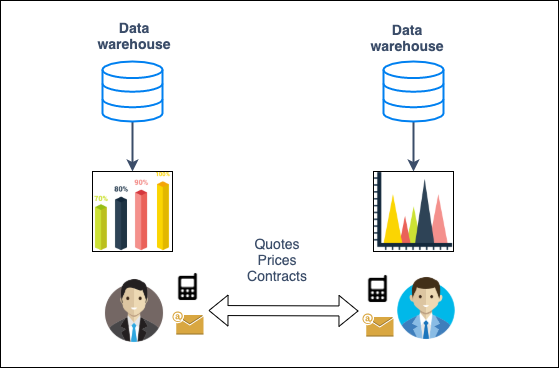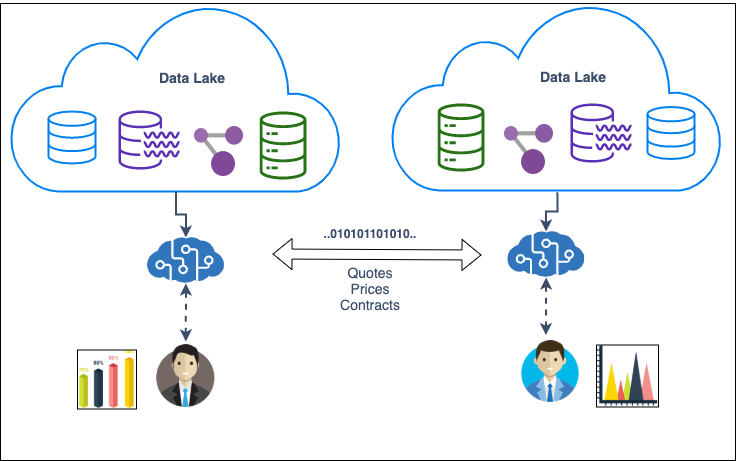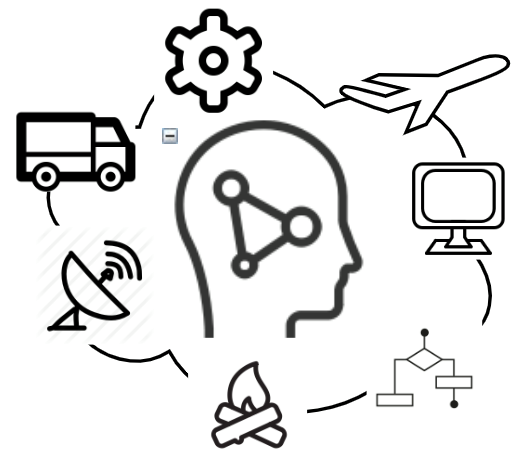
How to digitize your business right
The modern era of technology presents businesses with literally unlimited opportunities, but it comes with a price — companies must keep up with the pace of innovation, the speed of change and an ever-increasing competition. The latter, nowadays, became particularly challenging for many traditional businesses as competition often comes as a total surprise in the form of market disruptions from technology-driven startups. Recall what Amazon did to e-commerce, Uber to the taxi business and Airbnb to the hotel industry.
If you are not sure whether this post is related to your company, ask yourself the following questions:
- With the COVID-19 outbreak, was your transition to work-from-home smooth and without any significant disruption to your business?
- Do you have proven fault tolerant IT infrastructure in place? When did you actually test it last time?
- Is your IT infrastructure ready for a sudden opportunity to grow your business x2 or x3?
- Have you ever rejected new business ideas because of the high cost of IT budget to support it?
- Does your IT infrastructure serve as an enabler or a hindrance to your business innovation?
- And finally, do you have a technology roadmap for the next 5 years?
In this post I will discuss 5 essential elements of the modern digital business. I compiled this list based on my experience from building scalable enterprise grade solutions, reading books and articles and learning from examples and best practices presented on technical conferences.
Cloud
The first element is the Cloud. It seems to be obvious and ‘cloud’ had turned from a buzzword into an everyday routine quite some time ago. Yet my experience shows that many traditional businesses do not have enough expertise in technology to realize the cloud computing advantages to their full potential.
Let’s start with the most basic definition of cloud computing. According to PC Magazine:
“In the simplest terms, cloud computing means storing and accessing data and programs over the Internet instead of your computer’s hard drive.”
Even in its simplest form, which can be achieved just by migrating your existing IT infrastructure, databases and applications to the cloud and providing your users access to it over the internet, your business can gain a lot of value:
- reliability: fault tolerance, high availability and disaster recovery
- safety: it may feel counterintuitive, but if implemented right, cloud-based IT infrastructure will better protect your data, thanks to multiple layers of protection, deep expertise of the cloud providers and tools and services they provide
- availability: access from the internet allows users to work from almost any place including homes, which is not a luxury but rather a ‘must have’ reality as we all learned with the COVID-19 pandemic (though, there could be additional limitations related to the user interfaces and technologies they are built on, more on it below).
It is a great start, but unfortunately by itself it is not sufficient for today. The most successful companies are and will be those which embrace cloud technologies to gain an advantage from more advanced technical concepts, such as:
- elasticity: the ability to self-provision additional compute resource on-demand with efficient ‘pay-as-you-go’ cost model
- dynamic scaling in and out: ability to scale out to accommodate peak loads and scale in to not overpay for unused resources
- infrastructure as code: automated and efficient IT infrastructure provisioning and configuration
- continuous delivery and continuous deployment: a practice to release new features and versions of software in short incremental cycles in a reliable and fully automated way
- serverless cloud-native applications: a way to design, build, deploy and operate software without managing servers, physical or virtual, hence eliminating any infrastructure-related overhead and focusing purely on delivering useful business features.
A quick note on user interfaces. Even if you moved your servers to the cloud but users still have to use native desktop client applications pre-installed on the office workstations, it may become a business impediment in the economy of speed. Consider migrating your user interfaces to WEB and mobile applications, and keep in mind that they must be responsive and work on different devices, screen sizes and on a low network bandwidth.
Modular architecture with open API
Cloud computing discussed in the previous section provides a solid foundation, but in order to fully embrace it, your digital business solution must have the right architecture.
Hence, I call modular architecture with an open API the second essential element.
The concept of modular architecture in software development is best described these days as ‘microservice architecture’ and often contrasted with a more traditional ‘monolith application’ approach. Regardless of the exact terminology, this architecture style is based on the idea of building a complete end-to-end solution as a collection of smaller purpose-built software services working together to implement complex business workflows and processes.
Each module, or service, exposes well defined API endpoints which can be invoked by other services, or even by external systems or integration interfaces. In fact, in this approach the difference between some application service or an external system becomes vague, as an enterprise level a solution can be built as a ‘mix and match’ from in-house developed components, software form 3rd party vendors, consultancy agencies or even 3rd party services provided as SaaS (software-as-a-service). And ideally, your digital business architecture must have another property — be event-driven.
Why is this so important? A simple answer is to be able to quickly and with minimal efforts (meaning, investment) adjust or enhance your existing business workflows or implement new ones to respond to changes on the market or try new business ideas. So, it does not just improve your digital solution resilience and ability to scale, but may be an enabling factor for business innovation.
Focus on partnership and networking
The next essential element is the focus on partnership and networking.
Let’s briefly look back at the evolution of business automation software.
First developed software programs were focused on automating time-consuming routines replacing expensive and error prone manual labor in the operational context of a single company. And they did such a great job, that they defined the vision and the mindset for computer-based business automation for many years. And this type is still dominating in the world of enterprise and business software. For example, we still use Microsoft Word and Excel, not even speaking about more specific purpose-build business applications.
The development of communication technologies and the rise of the internet enabled a second wave of software programs aimed at communication and collaboration. An email client could be a good example, and for a number of years, supporting some form of data sharing and collaboration has been considered as a ‘must have’ feature for many business applications. Mentioned above Microsoft Word and Excel evolved into Office 360, a great tool for team work. But still it is mostly used by people within a single company and email remains a major tool to communicate with customers, vendors and partners. At best, most of the modern business solutions can automate sending emails.
But simple communication and even collaboration with your established counterparts, how it is supported by the current solutions, will not be sufficient in the future. Perhaps the very near future. The next generation digital business will have to explore complex professional networks of customers, vendors, suppliers and logistic services providers to discover new business opportunities and exploit them for optimizing cost or speed up time-to-market for your products. Think about personal social networks. Facebook or LinkedIn are pretty good in suggesting potential connections. The value is fairly limited in case of personal networks, but can be tremendous for businesses in the scope of B2B relations or supply chain optimization problems.
To achieve that, your digital business solution must be connected to some larger ecosystems. For example, in the supply chain and logistic domain, both: VC investors and existing market players have recognized the opportunity and, for a number of years, have been investing in various projects aimed at building such ecosystems. And while those are still mostly fragmented and cover some narrow sub-domains (a certain geographical region, or a specific market segment), the very fact provides a clear indication for the future direction. The next step will be consolidation and integration.
What does it mean for you? You need to start re-thinking your digital business solution to prepare it for integrating into a larger ecosystem. Implementing modular event-driven architecture with open API, described in the previous section, can be a good start.
AI ready
While a claim for ‘AI first’ may be a bit aggressive, ‘AI ready’ makes perfect sense to be considered as an essential element of any digital business, including supply chain management solutions or ERP systems.
If required, please read one of my previous posts ‘What is AI?’ for a quick and human-friendly introduction into the topic of AI (artificial intelligence). Perhaps you will be surprised to learn that even your current solution already benefits from some algorithms or techniques which generally belong to the AI domain, such as constraint satisfaction solving methods used in planning and optimization.
First, let’s deal with the terminology.
‘AI first’ is a concept emphasizing the priority of AI technologies at the very core of your digital business. If, for example, your current solution captures the data and makes it ready for reporting and analytics to support your decision making process, the ‘AI first’ solution will capture the data and, first of all, use it to train machine learning models. Moreover, when a human user will request some information from the system, the system may infer the user’s intentions and return results according to that, or provide some additional information or make some suggestions based on the context, available data and other various factors.
Technology innovation companies such as Google and Microsoft have announced their strategies as ‘AI first’. For others, more traditional businesses, it can be a bit too early to make such an aggressive move. AI is a rapidly developing space, and for those who are AI-technology consumers rather than providers, a more practical approach is to get ready, watch closely and look for opportunities to explore different AI technologies and techniques to solve specific problems for your business. This is what I call being ‘AI ready’. To better understand what exactly that means’, let’s look at how AI will transform the B2B world.
For example, let’s consider a logistic and supply chain business which traditionally was built on personal relations. Each company has its own database and some business intelligence solutions used by humans to make decisions. In this scenario, a personal human experience, supported by data, plays a significant role.

Now, let’s imagine how the decisions will be made and executed in the ‘AI first’ B2B world.

We can notice two key differences:
- intelligent agents are introduced in business workflows at first, to assist, and eventually, completely replace humans
- the intelligence of an AI agent directly depends on the amount and quality of the data, hence data plays a crucial role
To start the transition toward an AI ready state, the very first step is to realize the value of data and become a data-centric company. The more data you have today, the more intelligent your digital business will be tomorrow. I discussed this point in my previous post:
Why Social Networks, IoT, Big Data, Cloud and AI ?
So, first, your digital business solution will need to collect and process a vast amount of data at large scale. And the key to that challenge is the first essential element which is the cloud. It can provide various cost-efficient data store technologies, as well as literally unlimited on-demand scaling to support your business growth.
Second, your digital solution will need to integrate intelligent AI-driven agents (which are just programs, or services backed by AI technology) into your business workflows. And this brings us back to the second essential element — modular event-driven architecture with an open API.
And, finally, in order to do so, you will need one more essential element, which we will discuss in the next section.
Technology expertise
You need to have expertise, or at the very least, awareness in modern IT technology, and there is no way around it. Not surprisingly, Andreessen Horowitz VC firm’s (one of the best known venture capitals in Silicon Valley) motto is ‘Software Is Eating The World’. The only choice we all have is to stay ahead of ‘being eaten’.
For traditional businesses, and especially small and mid-size companies, who cannot allocate huge IT budgets or support internal IT departments, it may sound completely utopian, but fear not. Thanks to, yet again, cloud providers, such as Google and Amazon, and their ongoing innovation and competition, even such complex technologies like AI and machine learning are effectively commoditized and offered as services with APIs available for integration with almost every modern programming language or platform.
Another practical approach is to find a reliable partner to get quick access to IT technology expertise. But anyway, I would highly recommend that you start educating yourself and your employees. It will definitely not hurt.
And a few more thoughts for your consideration.
Don’t bind into a year-long project with a million dollar budget. Instead, develop your digitalization strategy but start with small practical goals, achievable in relatively short periods of time, like every month or so. Many software development companies aim at releasing new features every two weeks. Even if you hire a 3rd party firm, there is no reason to not get some incremental but practical results every 2–4 weeks. Revisit your strategy based on the results.
Go out and learn about what other companies are doing and what solutions they use to transform their businesses. There are great IT technology conferences taking place all around the world. They usually have multiple parallel tracks. Some of them are very technical and focused on IT professionals. But others are a good fit for business-minded people working at management levels. They present interesting IT solutions and real-life case studies from various industries and can serve as a great source of knowledge and inspiration. It can be an eye-opening experience.
Just a few useful links as an example:
AWS summits
https://aws.amazon.com/events/summits/
ThoughtWorks Technology Radar
https://www.thoughtworks.com/radar
Don’t wait and be determined in embracing IT technology. As Nassim Taleb describes in his famous book ‘Antifragile’, exposing yourself to some uncertainty and volatility every day, and perhaps making small mistakes and learning from them will increase your ‘antifragility’. Hiding and shielding yourself from the change will accumulate the risks leading to a huge distraction threatening your very business existence.
Conclusion
In this post I discussed five essential elements of modern approach to digitize your business.
Cloud computing with its on-demand elasticity, cost efficient ‘pay-as-you-go’ model and various value-added services and technologies provides a solid foundation to build your digital business.
Modular event-driven architecture allows exploiting cloud benefits to its full potential and helps your business to be agile in the economy of change.
Your digital business solution must focus not only on the internal corporate workflows, or automating communication with your existing customers, suppliers and partners, but also enable business innovation and drive new business opportunities.
AI ready means recognizing the value of data and becoming a data-centric company. Modular architecture will enable integrating intelligent agents to make and execute more efficient decisions.
To achieve it, you need to acquire and maintain IT technology expertise. Remember: ‘Technology is eating the world!’
Acknowledgments
A big “thank you” goes out to Patricio “Pato” Moschcovich, who did the proofreading for this post and provided invaluable feedback!
